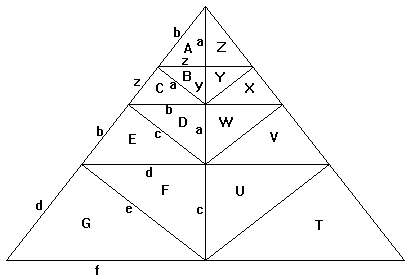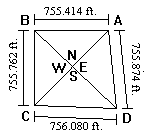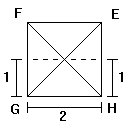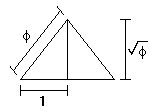Source for most of the diagrams:
"The Universal Language of Cabalah"
by William Eisen © 1989
The stuff taken from the book is excluded from the anti-copyright, because it's not my stuff.
The Great Pyramid Tree of Life
| Triangles |
|
Lines |
| A = C |
|
z + b = d |
| B + C = D |
|
y + a = c |

Though not to scale, this pyramid is based on the f ratio.
If z = 1, then b = f.
 |
|
| |
| Diagonal + Short Side |
= f |
|
|
|
Longside |
| | |
f = 1.618
( the velocity of light in nautical miles is 161,798 mi/sec )
Half the perimeter of the Base (4) divided by the Altitude (sq. root of phi) should give pi. Pi multiplied by the Altitude should give half the perimeter of the Base as it's product. The product of pi and the square root of phi is 3.996. This is close, but it isn't 4.
However, this is a diagram of a "perfect" pyramid. The Base of the Great Pyramid at Giza does not make a square.

If we take the southern face as the standard of the above left "perfect" pyramid when measuring the Base perimeter, we see why it was built the way it was. When we compare the length of the Base of the northern face to this standard it doesn't equal four.
Half of 756.080 equals 378.040 (one unit), and half of 755.414 equals 377.707. Now, by dividing 377.707 by 378.040 we see that one unit on the northern side of the perimeter equals 0.999 of a southern unit. 0.999 times four units (for half the perimeter) gives us 3.996 units, thus satisfying the equation: half the perimeter of the Base (3.996) divided by the Altitude (1.272) gives us pi.
Lilith's Temple
For comments or whatever contact :
Kenny <lilithstemple@geocities.com>





